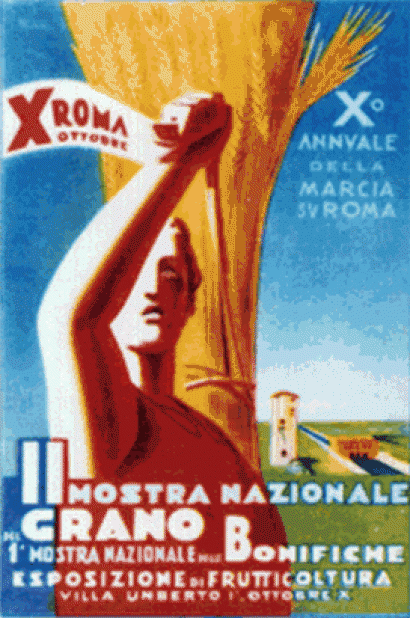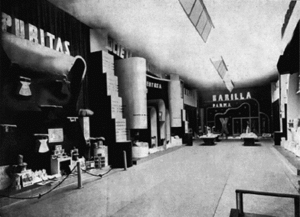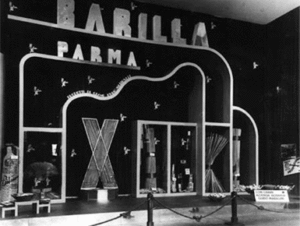National Wheats Exposition. Rome, 1932

Rome. Second National Wheats Exposition. 1932.
A deep transformation in terms of taste and expositional “aesthetics” is strongly visible in the Barilla stand, presented in Rome during the “Second National Wheats Exposition”, October 1932, in occasion of the “Manifestazioni del Decennale” of the power of Fascism.
Inside the release, extended to all the companies dealing with “Milling and Pasta Manufacturing”, the chance of disposing of a considerably large expositional space contributed to characterize a stand that was conceived as avant-corps that clearly stood out on a velvet curtain.
The composition, formed by blades realized with light colored and strongly thick wood, determines a series of “windows” and linear and curved shelf that define the recesses where Barilla pasta was exposed.
A low prismatic support sustains, according to a symbolic function, the Roman number “X”, transformed into a container which is suitable to host a waterfall of ziti and spaghetti, visible under glass, on the left side of the composition.
On the long flat surface, that delimits the height of the stand, BARILLA sign stands out in cubital letters, while in the underlying support there was the PARMA sign and along the wavy central “portal” people could read the signal “Products made of National durum wheat”.
As already happened at the first Roman exposition, to attend the event there was the Head of Government who, as informed by the daily Popolo d’Italia of 4 October 1932 stopped “with special interest in front of the Barilla Pasta Plant stand from Parma, which employs 500 people guaranteeing a strong daily production”.
It would be extremely reductive not to mention the general features of the Exposition to which famous pasta, bread and milling companies from several Italian cities took part.
As it’s visible also from the overall views of the staging areas, in our possess thanks to photographic documents kept in the Barilla Historical Archive, the expositional situation presents a lot of interesting points.
The “expositions” are placed in double row along the walls of a huge pavilion that presents as privileged backdrop the Barilla stand.
A generic usage of evaporated woods is clear and they allow a high rate of flexibility of the material used. In the various distributive and compositional design context, the prevailing element is the technic of applying a decorative slab of wood made of sheets that could be bent according to any taste. This explains the numerous presence of arches, used for many purposes, which characterize the path of the exposition (1).
While elaborating a judgement, we sustain to be impartial if we attribute a higher gear to the functionality, the elegance, the 20th century symbolism of Barilla stand, thanks to which the Parmesan Company was awarded with the golden medal by the commission.

